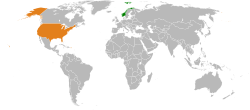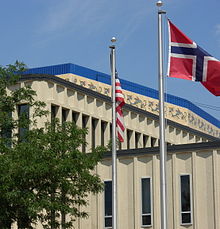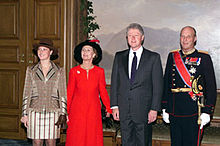- Norway–United States relations
-
American-Norwegian relations 

United States
Norway Harald V of Norway, during a Full Honor Ceremony (FHC) on his behalf of his official visit to the United States celebrating 100 years of diplomatic relations between The Kingdom of Norway and the United States of America and to deliver relief supplies to assist in the Hurricane Katrina recovery efforts.
Harald V of Norway, during a Full Honor Ceremony (FHC) on his behalf of his official visit to the United States celebrating 100 years of diplomatic relations between The Kingdom of Norway and the United States of America and to deliver relief supplies to assist in the Hurricane Katrina recovery efforts.
 Harald V of Norway and Queen Sonja of Norway, greeted by Laura and George W. Bush at the White House during the March 2005 State Visit to the U.S.
Harald V of Norway and Queen Sonja of Norway, greeted by Laura and George W. Bush at the White House during the March 2005 State Visit to the U.S.
Norway – United States relations are bilateral relations between Norway and the United States. The United States and Norway have a long tradition of positive relations.
The American Revolution of 1776 had a profound impact on Norway, and the democratic ideals of the U.S. Constitution served as a model for the authors of Norway's own Constitution of 1814. The close relationship between the two nations was reinforced by massive Norwegian emigration to the U.S. during the period 1825–1940, when more than 850,000 Norwegians made new homes in the United States and helped build the nation. During the post-war era, both the Marshall aid and the strong common commitment to NATO have contributed to the powerful bond between the two countries. The friendly state of the bilateral relationship was reinforced when King Harald V of Norway hosted the visit of U.S. President Bill Clinton in November 1999, the first visit to Norway by a U.S. President in Office.
The excellent relations between Norway and the United States, and the Mission in Oslo can focus its efforts on projects that serve mutual interests. Among them are expanding on the success of NATO in securing transatlantic security, promoting new business opportunities between the two nations, working with Russia to preserve the Arctic environment and the Barents Sea, helping the Baltic nations to find their place in the new Europe, and capitalizing on information technology to promote human rights and a sense of world community.
Contents
Embassies
Principal U.S. officials:
- Ambassador – Barry B. White
- Deputy Chief of Mission – Kevin M. Johnson
- Counselor for Political-Economic Affairs – Kristen F. Bauer
- Counselor for Public Affairs – Hillary Olsin Windecker
- Management Officer—Nathan Bluhm
- Chief, Consular Section—Rodger Deuerlein
- Defense Attaché--Capt. Russell H. Smith, USN
- Chief, Office of Defense Cooperation—Col. Robert Simm, USAF
- Labor Attaché--Edward T. Canuel
- Regional Security Officer—Eric Carlson
see also United States Ambassador to Norway, Embassy of the United States in Oslo
The U.S. maintains an embassy in Oslo. Norway maintains an embassy in Washington DC, United States, and four consulates in New York City, Houston, San Francisco and Minneapolis.
-
The United States embassy in Oslo
Norwegian Americans
Further information: Norwegian AmericanThere are more than 4.5 million people of Norwegian ancestry in the United States today.[1] Of these, approximately three million claim "Norwegian" as their sole or primary ancestry.
- A little more than 2% of whites in the United States are of Norwegian descent. In the Upper Midwest, especially Minnesota, western Wisconsin, northern Iowa, and the Dakotas, more than 15% of whites are of Norwegian descent. Nearly one-third of all North Dakotans claim Norwegian as their ancestry.[citation needed]
- 55% of Norwegian Americans live in the Midwest, although a large number (21%) live in the Pacific States of Washington, Oregon, and California.
- Norwegian Americans actively celebrate and maintain their heritage in many ways. Much of it centers on the Lutheran-Evangelical churches they were born into, but also culinary customs (e.g., lutefisk and lefse), costumes (bunad), and Norwegian holidays (Syttende Mai, May 17) are popular. A number of towns in the United States, particularly in the Upper Midwest, display very strong Norwegian influences.
- Although the Norwegians were the most numerous of all the Scandinavian immigrant groups, other Scandinavians also emigrated to America during the same time period. Today, there are 11–12 million Americans of Scandinavian ancestry. Scandinavian descendants represent about 6% of the white population in the United States as a whole, and more than 25% of the white population of the Upper Midwest.
- Norwegian Americans tend to be Lutheran, although substantial minorities are Roman Catholic or belong to other Protestant denominations. See The Norwegian Lutheran Church in the United States.
- There are more people of Norwegian ancestry in America than in Norway. Historically high birth rates over the past hundred years among Norwegian-Americans resulted in their roughly quadrupling in population over the original ~850,000 immigrants.
Country comparison
 Norway
Norway United States
United StatesPopulation 4,842,915 312,637,000 Area 385,252 km2 (148,746 sq mi) 9,629,091 km2 (3,717,813sq mi) Population Density 12.5/km22 (31/sq mi) 31/km2 (80/sq mi) Capital Oslo Washington, D.C. Largest City Oslo – 580,229 (1,422,442 Metro) New York City – 8,363,710 (19,006,798 Metro) Government Unitary parliamentary constitutional monarchy Federal presidential constitutional republic Official languages Norwegian English (de facto) Main religions 85% Protestant, 10% other, 2% Muslim, 1% Pentecostalism, 1% Roman Catholic 75% Christianity, 20% non-Religious, 2% Judaism, 1% Buddhism, 1% Islam Ethnic groups 89.4% Norwegian and Sami, 10.6% other 74% White American, 14.8% Hispanic and Latino Americans (of any race), 13.4% African American,
6.5% Some other race, 4.4% Asian American, 2.0% Two or more races,
0.68% American Indian or Alaska Native, 0.14% Native Hawaiian or Pacific IslanderGDP (nominal) 2008 IMF estimates: US$451.830 billion[1] ($94,386 per capita) [1] 2008 IMF estimates: US$14.441 trillion[1] ($47,440 per capita) [2] References
- ^ a b c "World Economic Outlook Database". International Monetary Fund. http://imf.org/external/pubs/ft/weo/2009/02/weodata/weorept.aspx?sy=2008&ey=2008&scsm=1&ssd=1&sort=country&ds=.&br=1&c=512%2C941%2C914%2C446%2C612%2C666%2C614%2C668%2C311%2C672%2C213%2C946%2C911%2C137%2C193%2C962%2C122%2C674%2C912%2C676%2C313%2C548%2C419%2C556%2C513%2C678%2C316%2C181%2C913%2C682%2C124%2C684%2C339%2C273%2C638%2C921%2C514%2C948%2C218%2C943%2C963%2C686%2C616%2C688%2C223%2C518%2C516%2C728%2C918%2C558%2C748%2C138%2C618%2C196%2C522%2C278%2C622%2C692%2C156%2C694%2C624%2C142%2C626%2C449%2C628%2C564%2C228%2C283%2C924%2C853%2C233%2C288%2C632%2C293%2C636%2C566%2C634%2C964%2C238%2C182%2C662%2C453%2C960%2C968%2C423%2C922%2C935%2C714%2C128%2C862%2C611%2C716%2C321%2C456%2C243%2C722%2C248%2C942%2C469%2C718%2C253%2C724%2C642%2C576%2C643%2C936%2C939%2C961%2C644%2C813%2C819%2C199%2C172%2C184%2C132%2C524%2C646%2C361%2C648%2C362%2C915%2C364%2C134%2C732%2C652%2C366%2C174%2C734%2C328%2C144%2C258%2C146%2C656%2C463%2C654%2C528%2C336%2C923%2C263%2C738%2C268%2C578%2C532%2C537%2C944%2C742%2C176%2C866%2C534%2C369%2C536%2C744%2C429%2C186%2C433%2C925%2C178%2C746%2C436%2C926%2C136%2C466%2C343%2C112%2C158%2C111%2C439%2C298%2C916%2C927%2C664%2C846%2C826%2C299%2C542%2C582%2C443%2C474%2C917%2C754%2C544%2C698&s=NGDPD&grp=0&a=&pr.x=35&pr.y=9.
- ^ "World Economic Outlook Database". International Monetary Fund. http://imf.org/external/pubs/ft/weo/2009/02/weodata/weorept.aspx?pr.x=26&pr.y=9&sy=2008&ey=2008&scsm=1&ssd=1&sort=country&ds=.&br=1&c=512%2C941%2C914%2C446%2C612%2C666%2C614%2C668%2C311%2C672%2C213%2C946%2C911%2C137%2C193%2C962%2C122%2C674%2C912%2C676%2C313%2C548%2C419%2C556%2C513%2C678%2C316%2C181%2C913%2C682%2C124%2C684%2C339%2C273%2C638%2C921%2C514%2C948%2C218%2C943%2C963%2C686%2C616%2C688%2C223%2C518%2C516%2C728%2C918%2C558%2C748%2C138%2C618%2C196%2C522%2C278%2C622%2C692%2C156%2C694%2C624%2C142%2C626%2C449%2C628%2C564%2C228%2C283%2C924%2C853%2C233%2C288%2C632%2C293%2C636%2C566%2C634%2C964%2C238%2C182%2C662%2C453%2C960%2C968%2C423%2C922%2C935%2C714%2C128%2C862%2C611%2C716%2C321%2C456%2C243%2C722%2C248%2C942%2C469%2C718%2C253%2C724%2C642%2C576%2C643%2C936%2C939%2C961%2C644%2C813%2C819%2C199%2C172%2C184%2C132%2C524%2C646%2C361%2C648%2C362%2C915%2C364%2C134%2C732%2C652%2C366%2C174%2C734%2C328%2C144%2C258%2C146%2C656%2C463%2C654%2C528%2C336%2C923%2C263%2C738%2C268%2C578%2C532%2C537%2C944%2C742%2C176%2C866%2C534%2C369%2C536%2C744%2C429%2C186%2C433%2C925%2C178%2C746%2C436%2C926%2C136%2C466%2C343%2C112%2C158%2C111%2C439%2C298%2C916%2C927%2C664%2C846%2C826%2C299%2C542%2C582%2C443%2C474%2C917%2C754%2C544%2C698&s=NGDPDPC&grp=0&a=.
 This article incorporates public domain material from websites or documents of the United States Department of State (Background Notes).[1]
This article incorporates public domain material from websites or documents of the United States Department of State (Background Notes).[1]External links
 Media related to Norway – United States relations at Wikimedia Commons
Media related to Norway – United States relations at Wikimedia Commons Foreign relations of the United States
Foreign relations of the United StatesBilateral relations Africa Algeria · Angola · Benin · Botswana · Burkina Faso · Burundi · Cameroon · Cape Verde · Central African Republic · Chad · Comoros · Democratic Republic of the Congo · Republic of the Congo · Côte d'Ivoire (Ivory Coast) · Djibouti · Egypt · Equatorial Guinea · Eritrea · Ethiopia · Gabon · The Gambia · Ghana · Guinea · Guinea-Bissau · Kenya · Lesotho · Liberia · Libya · Madagascar · Malawi · Mali · Mauritania · Mauritius · Morocco · Mozambique · Namibia · Niger · Nigeria · Rwanda · São Tomé and Príncipe · Senegal · Seychelles · Sierra Leone · Somalia · South Africa · South Sudan · Sudan · Swaziland · Tanzania · Togo · Tunisia · Uganda · Zambia · ZimbabweAsia Middle East Bahrain · Egypt · Iran · Iraq · Israel (Military relations) · Jordan · Kuwait · Lebanon · Oman · Qatar · Saudi Arabia · Syria · United Arab Emirates · YemenElsewhere Afghanistan · Bangladesh · Bhutan · Brunei · Burma · Cambodia · People's Republic of China (Hong Kong · Macau) · East Timor · India · Indonesia · Japan · Kazakhstan · Kyrgyzstan · Laos · Malaysia · Maldives · Mongolia · Nepal · North Korea · Pakistan · Philippines · Russia · Singapore · Sri Lanka · South Korea · Republic of China (Taiwan) · Tajikistan · Thailand · Turkmenistan · Uzbekistan · VietnamEurope Albania · Andorra · Armenia · Austria · Azerbaijan · Belarus · Belgium · Bosnia and Herzegovina · Bulgaria · Croatia · Cyprus · Czech Republic · Denmark · Estonia · Finland · France · Georgia · Germany · Greece · Hungary · Iceland · Ireland · Italy · Kosovo · Latvia · Liechtenstein · Lithuania · Luxembourg · Macedonia · Malta · Moldova · Monaco · Montenegro · Netherlands · Norway · Poland · Portugal · Romania · Russia · San Marino · Serbia · Slovakia · Slovenia · Spain · Sweden · Switzerland · Turkey · Ukraine · United Kingdom (Special Relationship) · Vatican CityNorth America Caribbean Antigua and Barbuda · Aruba · Bahamas · Barbados · Bermuda · Cayman Islands · Cuba · Dominica · Dominican Republic · Grenada · Haiti · Jamaica · St. Kitts and Nevis · St. Lucia · St. Vincent and the Grenadines · Trinidad and TobagoElsewhere Belize · Canada (Trade) · Costa Rica · El Salvador · Guatemala · Honduras · Mexico · Nicaragua · PanamaOceania ANZUS Australia · New ZealandElsewhere Fiji · Kiribati · Marshall Islands · Micronesia · Nauru · Palau · Papua New Guinea · Samoa · Solomon Islands · Tonga · Tuvalu · VanuatuSouth America Argentina · Bolivia · Brazil · Chile · Colombia · Ecuador · Guyana · Paraguay · Peru · Suriname · Uruguay · VenezuelaFormer states Kingdom of Hawaii · Netherlands Antilles · Republic of Texas · Russian Empire · Soviet Union
Multilateral relations Arab League · European Union · Latin America · Africa · United Nations · Third Border Initiative · International organizationsDoctrines, policies, concepts Presidential
doctrinesProclamation of Neutrality · Monroe · Roosevelt Corollary · Good Neighbor policy · Truman · Eisenhower · Kennedy · Johnson · Nixon · Carter · Reagan · Clinton · Bush · ObamaOther doctrines Policies and
concepts Foreign relations of Norway
Foreign relations of NorwayAfrica Democratic Republic of the Congo · Morocco · Sudan · Western SaharaAsia Europe North America Canada · United States ·Oceania Australia · New ZealandMultilateral relations European Union Categories:
Categories:- Bilateral relations of the United States
- Bilateral relations of Norway
- Norway–United States relations
Wikimedia Foundation. 2010.





